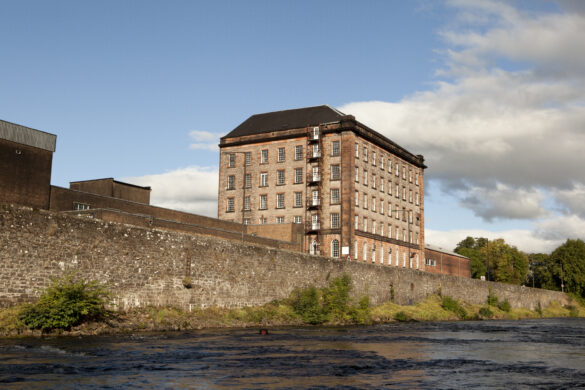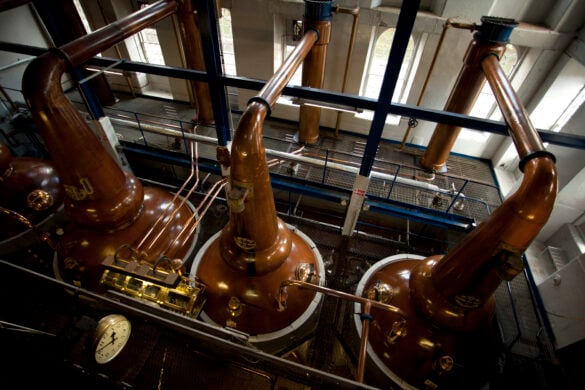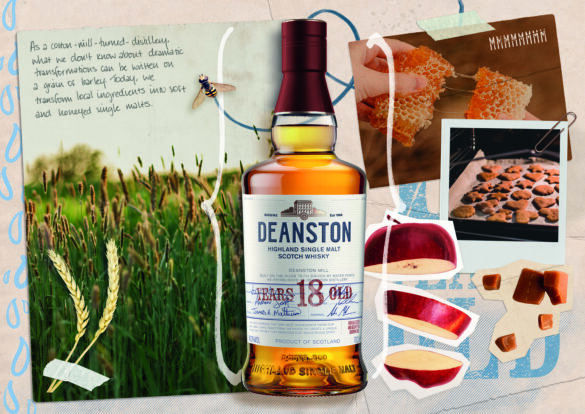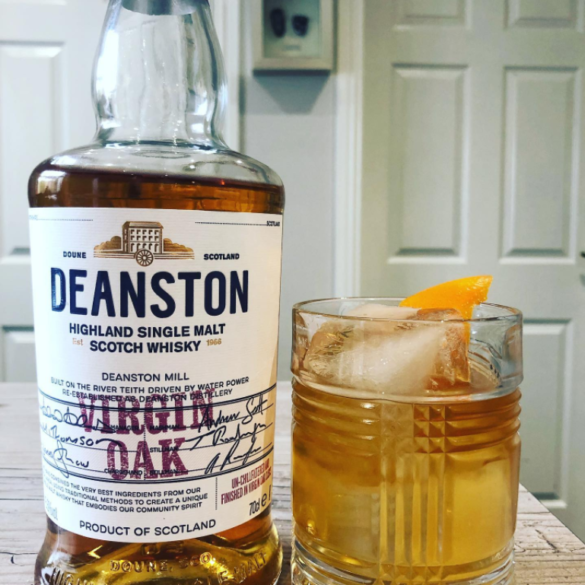When Brendan McCarron arrived at Deanston in 2021, he was greeted by terrible news. The distillery’s flagship 18-year-old expression had recently been de-listed. “I went outside and screamed into a bag,” Brendan tells us. “Then I came back in and composed myself and went ‘let’s try our best to keep the 18’ because it really is the rock star Deanston whisky… and it won a big award, I’ve heard?”
Indeed it has. Deanston 18 Year Old won convincingly at our annual Whisky of the Year blind tasting at the end of 2021, seeing off competition from heavyweight distilleries like Mortlach and Old Pulteney. We met with Brendan to discuss the secrets of Deanston’s waxy spirit character, this year’s winning whisky, and the best way to make a Deanston old fashioned.

Brendan McCarron: Master distiller, barley whisperer, wax wizard
What was it like leaving Glenmorangie for Deanston?
That was almost a year ago now and it was with quite a bit of trepidation. I’m pretty confident in my own abilities and I have faith in what I can do, but it was still a big move. And it was going great and I was really enjoying it and I was very happy, but there was something missing. I was working in blending and creating but I did miss the production side, I wanted to put it all together. And so that’s what I saw at Distell, which includes Deanston but has me across all of our distilleries and all of our whiskies.
Was there a particular appeal to Deanston?
I felt like there was massive opportunity with Deanston and I felt there was this incredible, incredible whisky that was a little bit undersold. I’m a geek at heart and Deanston is a super-geeky whisky. I always knew about this crazy, waxy character that it creates. And the great thing about my job is that it’s about getting all the secrets and getting the recipes and all the ingredients. I really wanted to rip it apart.
It’s also a distillery that I live very close to, it’s about ten minutes’ drive from my house. And I’ve had history with it because I used to buy Deanston spirit when I worked at Diageo and use it to make Johnnie Walker. So there was just all these things happening and when I joined it was just a crazy nine months, joining during COVID and meeting my boss one time in six months was insane.
But it’s honestly given me a new lease on life. I’m back out travelling between distilleries, I’m back into production and there’s a real rhythm and a heartbeat to that. I get to eat my cake and have it too, because I get to make all the whiskies as well as getting to blend and to create and get to do slightly strategic stuff because I’m really trying to influence how much stock we make and how much we lay down. I get to do blended Scotch because I was only doing malts before and I also get to make gin and I get to work with great people. I’ve got zero regrets, I’m just absolutely loving it.

Deanston distillery occupies the old Adelphi Mill which opened in 1875
And how does the spirit get that waxy character?
To make a waxy spirit, it’s kind of like a combination of witchcraft, magic, luck and a wee bit of science as well. You want have super-clear wort, so you need a very slow, steady mashing regime. Which works for us because we have a traditional open-topped mash tun. You also want to do a super-long fermentation because that allows esterification and the creation of all those fruit flavours. It’s kind of like concentrated fruit. But you don’t want to ferment for too long, because if you go for too long it’s going to start going floral. Now, floral is lovely but it isn’t going to cut it for waxy.
Then, there’s this incredible single vessel where the fermented wash goes and also the heads and the tails of other distillations as well. There’s this constantly in flux, constantly changing feints charger, almost like an infusion chamber, and in there the alcoholic concentration is always changing. You get layering of some of the fatty acids and the different alcohols and you get these levels, almost like a layer cake. If you could somehow get in there and take it out at different sections there’d be different things happening, different flavours there.
You also get – it’s not so good for the marketing, but it’s good for the geeks – you get this crazy black wax in there, almost like gunge that forms around the top. It looks like superheroes, it looks like Venom. And what’s even cooler is if you take this stuff out of the feints charger, this infusion chamber, to try to find out what it is it almost immediately, goes completely clear. Because it only thrives in an alcohol-rich environment. So, when you take it out it’s like it disappears.
But It’s that layering, changing, infusion that when you then distil that, it goes from being a very fruity to spirit to being this waxy spirit. My favourite way to describe it is: Imagine eating an orange like it was an apple. You bite, you get that texture of the orange skin, and you bite a little further and you get this explosion of juice – that’s Deanston.
Is it right to say this is an old-fashioned style of whisky?
Well I do like to drink a Deanston Old Fashioned every Friday, if that’s what you mean.
I think as single malt whisky has grown up two things have come out on top and that’s those really classic Speyside and Highland fruity whiskies with the other style being smoky, peaty whiskies. And it’s really these two styles that have dominated.
But as the people who drink single malt are maturing, and as the people who drink single malt are getting more curious, and as more people drink single malt, I’m really noticing a kind of thirst for more and a thirst for different. And that’s why you see a huge range of innovations from various distilleries where they’re going ‘hey, we normally do an un-peated, here’s a peated one. We’re normally in Bourbon, here’s a sherry.’ Because people really want to see it in a different way.
But the other thing that’s happening is you’re seeing these single malt distilleries that have had very different characters and make blends incredible – but it almost feels like it’s their time to shine. I’m thinking of competitors like Mortlach, which was totally unknown unless you knew about it. And now everyone’s going ‘holy shit, this stuff’s incredible’. Stuff like Clynelish, for the same reason – incidentally, the other waxy distillery in Scotland. Dailuaine, Linkwood, Longmorn, I could go on and on – and I really feel like that’s where Deanston is right now. It’s this brilliant single malt you can just drink and enjoy if you’re new to whisky but also for the people who want different and unusual.
So I don’t know if that makes it an old fashioned whisky or not but it’s a different whisky.

The stillhouse at Deanston
Has this signature style changed much over the years?
I certainly have made some changes immediately. I increased the gravity in the washbacks because higher gravity promotes greater production of esters and fruity flavours. And that is one of the key parts to making waxy spirit. And we have noticed the consistency of our spirit and the waxy level is more consistent. It’s always been waxy but it just jumps up and down less.
I think, this is just an assumption, but I think when they opened the distillery in the 1960s, I don’t think they said ‘we are going to be the distillery that makes the waxy spirit’ – I don’t think that’s what they set out to achieve. But I think it’s the design and the steel in the washbacks and the type of vessel that they put in the stillhouse.
What I think is genius is that someone’s tasted It and said ‘well this isn’t what we were trying to make, but it’s amazing, let’s just keep doing this’ and I think that’s the cool part of it. I don’t think it was ever by design.
What about using 100% Scottish barley at the distillery, is that a recent change?
When the switch happened, I’ve no idea. But it’s been that way for a long time. To be honest with you it’s probably always been Scottish barley for Deanston but it’s not a legal requirement for the barley to be from Scotland.
You can actually split the UK right down the middle, the west coast – which is there I’m from, so obviously better – is hotter and wetter so it’s good for grass, which is why farmers that are breeding animals are on the west. The east coast is colder and dryer, so it’s a bit easier, a bit more predictable, there’s far less rain and that’s where you grow all the barley. So effectively, half of Scotland’s land is useless for growing barley, only half of it is good for growing barley. So all the way down the east coast and all the way down into East Anglia is again fantastic for producing barley. But the stuff from England tends to be higher in nitrogen and higher nitrogen suits brewers. So, it tends to be brewers who buy English barley, distillers buy Scottish barley.
I’d love to stand up and say the reason we choose it is because Scottish barley tastes better than any other barley in the world. But it’s not really that, it’s really that with Scottish barley it’s more sustainable, it’s far more supportive of the farming community. It just makes sense, you know.
What can we look forward to from Deanston in the near future?
When I started, the 18-year-old had already been de-listed, it had been announced that we weren’t going to be making it anymore and I was like ‘that’s not happening’. So a lot of our work is going to be just managing our stock to make sure the 18-year-old stays on shelf and is never ever, ever questioned again.
I want to make less one-off whiskies but the ones that I make I want to make them in a bigger scale. And the other thing that I’m really working hard on is refining the Virgin Oak recipe because it’s my favourite Deanston and was before I joined, but I think we can make it even sharper, make it really just pop a wee bit more. And that’s with the wood suppliers that I have the cooperages and giving them a little nudge to say ‘can you get me different toastings, can you get me char four on the casks’ and I’ve been ordering them since April when I started. That’s going to be an evolution rather than a new recipe for virgin oak, I’m just slowly tinkering with it and I’m increasing the average age as well.
beyond that, because Deanston’s got that waxy spirit, it’s got that incredible lightness and touch and still got a strong spine, you can kind of do anything to it. It works in wine casks it works in Bourbon it works in sherries of all kinds. So I think quite a few sherried experiments are where my head’s at for the special editions.
But the main thing is just to lay down more stock for single malt and start screaming about Deanston because it Deserves to be screamed about.

An award-winning dram
What can you tell us about the Deanston 18, what’s inside?
With Deanston, it really is a story of waxy spirit and American oak. It’s a lot of first fill ex-Bourbon, with a bit of second fill ex-Bourbon and a touch of refill sherry casks. But the sherry’s almost… you don’t need to know about the sherry casks because they’re refills, they’re in there for balance. So really it’s about getting that perfect balance between waxy spirit from the distillery and American oak.
It’s more oak-led than spirit-led as you’d expect from it being 18 years old. It has the classic candied orange peel that Deanstons always have but there’s also pears and apples in there and a real softness to the wax as well, it has a real lightness about it. But it also has some of those good classic whisky flavours, the caramel, the honey, the little bit of spice that’s in there. I’m a big texture person when it comes to food and drink and this has an incredibly long finish on it and an amazing feeling as you drink it, it’s soft, it’s light, but at the same time oily and waxy. It just has everything going on in it.
It’s the most overused word in whisky, unfortunately, but it’s a very complex dram.
So between the 18 and the Virgin Oak?
The 18 is the whisky that I’m proudest of, because I had a big influence in terms of saying ‘let’s not stop it. Please let me make some more.’ But I think Deanston Virgin oak has been my favourite for such a long time that it probably remains the one that I reach for the most often. But I reckon if you get 10 fans of Deanston in a room and ask them what their favourite is, eight or nine at the minimum are going to say the best is the 18-year-old.

A Virgin Oak Old Fashioned done right. Credit: @mcc_brendan
And that’s what you drink on a Friday evening?
Nearly every Friday on Instagram, we have Old Fashioned Fridays where we all make an Old Fashioned and tag each other. And there’s a lot of people going ‘I’d never made a Virgin Oak Old Fashioned and it’s really good’ and I’m saying ‘I told you’.
Classic fruity American oak matured Scotches are great for Old Fashioneds and with Deanston you just add that layer of wax and off you go. I make my own simple syrup, which is the easiest thing in the world to make: one scoop of sugar, one scoop of water, leave it for 24 hours and you’re in.
I’ve got various bitters that I’ve sort of experimented around with. My two favourites are the classic Angostura and the other one that I’ve got really into is almost like doubling or tripling down on the orange notes with two dashes of orange bitters and a big garnish of orange peel. Seriously express out all those orange oils.
I think them quite savoury, just the tiniest bit of simple syrup, so quite boozy I guess is the right word. And then I just stir that down, get the dilution, and of you go.
I like to kid on that I’m Mr Lyan for the day. You know he does this beeswax old fashioned and I’m thinking beeswax honey old fashioned with Deanston is just going to be the dream.
Brendan’s Virgin Oak Old Fashioned
Ingredients
50ml Deanston Virgin oak
1:1 Simple Syrup to Taste
2 Dashes Angostura or Orange Bitters
Orange peel
Method
Combine the simple syrup, bitters and 50ml of whisky in a rocks glass and fill to the brim with ice. Stir, changing directions occasionally, until the whisky is diluted and the ice has melted a little. Add more ice and the remaining whisky and continue to stir until the dilution is right for you. Garnish with your slice of orange peel and serve immediately.








 Enjoy responsibly
Enjoy responsibly
Recent Comments
Unfortunately, the answer is 'between 400g and 2000g per litre' :)
Posted on: 9 October 2024
What ratio of Sloe to gin is used, I see anything from 400 to 2000g of sloe to 1 litre of gin!
Posted on: 7 October 2024
What really makes Bob Harris' predicament in 'Lost In Translation' so absurdly funny is that he nailed it in one take, and the director just couldn't accept that.
Posted on: 11 January 2024